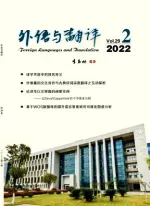英语get型被动结构分析*
刘 蔚
(黄冈师范学院外国语学院,湖北黄冈438000)
动词get+v-ed分词结构称为get型被动结构。英语get型被动结构既可以表示动作,又可以表示状态。也就是说,英语get型被动结构既可以是行为被动语态,又可以是状态被动语态。无论get型被动结构表示动作还是状态,其v-ed形式必须由动态及物动词构成。这是因为静态动词表示状态或者感觉,一般不能用于被动语态,当然也不能用于get型被动结构。get型被动结构具有自己的时体形式。
一、get型行为被动结构
当get型被动结构中的v-ed分词由延续性及物动词构成时,往往表示动作,get型被动结构为行为被动结构。get型行为被动结构有相应的主动结构。例如:
(1)a.The student got punished by the teacher for his cheating in the exam.
b.The teacher punished the student for his cheating in the exam.
(2)a.More and more countries are getting attacked by the terrorists.
b.The terrorists are attacking more and more countries.
上述两例中的v-ed分词punished和attacked分别由延续性及物动词punish和attack构成,具有动态意义,表示行为动作。由于是行为被动结构,所以上述两例可以带有表示行为发出者的介词短语by the teacher和by the terrorists.在get型行为被动结构中,动词get为助动词,没有词汇意义,不能当操作词,需借助助动词 do(don’t,does,doesn’t)或者 did(didn’t)构成疑问、否定或者强调句式。例如:
(3)How did the car get broken down?
(4)She doesn’t get paid.
(5)I do get invited to their wedding.
get型行为被动结构有自己的时体形式,可用于一般现在时,一般过去时,一般将来时,现在进行时,过去进行时,现在完成时和过去完成时。例如:
(6)The house gets white - washed every third year.
(7)The car got broken down when we drove back.
(8)You will get paid tomorrow.
(9)More and more countries are getting attacked by the terrorists.
(10)The workers were getting employed by the boss.
(11)That team has got defeated.
(12)Tom had got killed in the accident when the people found him.
get型行为被动结构可用作不定式。例如:
(13)We hear that we are going to get paid by hours.
get型行为被动结构具有独特的语义特征。get型行为被动结构表示动作,而不表示状态。get型行为被动结构可以避免像be型行为被动结构那样出现歧义。例如:
(14)a.They were defeated in that game.
b.They got defeated in that game.
(14)a既可表示“他们在那场比赛中处于败局”,也可表示:“他们在那场比赛被
打败。”而(14)b只表示“他们在那场比赛中被打败。
get型行为被动结构有时可以表示行为结果是主语自己造成的。例如:
(15)The driver got hurt in the accident.
get型行为被动结构可表示突发事件或事故,常与in the end,eventually,at last等
副词搭配。例如:
(16)He got caught in the rain.
(17)Eventually he got invited to give a lecture in the uni-versity.
二、get型状态被动结构
get型状态被动结构与be型状态被动结构一样,相当于SVC结构。在get型状态被动结构中,动词get与be型状态被动结构中的动词be一样,是表示结果的连系动词。v-ed分词相当于形容词,具有静态意义,作补语,表示主语所具有的状态特征或者主语由于动作的结束所导致的行为结果。get型状态被动结构也可以看作一种假被动语态结构,以被动形式表示主动意义。get型状态被动结构中的v-ed分词可由终止性及物动词和导致某种状态变化的及物动词,包括心理使役动词和色彩使役动词构成。例如:
(18)We are getting bogged down in all sorts of problems.
(19)They got married last month.
(20)She got surprised and overjoyed at the good news.
(21)The young man got tanned in the summer vocation.
(22)Tom got too absorbed in his novel to hear the knock at the door.
此外,get型状态被动结构中的v-ed分词还可由接反身代词的及物动词构成。这时,get型状态被动结构所表示的意义相当于“transitive verb+oneself”结构。例如:
(23)a.He got dressed and went downstairs.
b.He dressed himself and went downstairs.
(24)a.The official got engaged in the taking-bribe.
b.The official engaged himself in the taking-bribe.
get型状态被动结构中的get不能当操作词,需借助助动词 do(don’t,does,doesn’t)或者 did(didn’t)构成疑问、否定或者强调句式。例如:
(25)How did the cart get stuck in the mud?
(26)She doesn’t get accustomed to the Sichuan food.
(27)The more I hear,the more I do get confused.
get型状态被动结构除了具有get型行为被动结构型的7种时体形式外,还有将来进行时和完成进行时两种时体形式。例如:
(28)Some college students will be getting interested in online learning.
(29)Recently they have been getting engaged in that project.
get型状态被动结构也可用作不定式。例如:
(30)We hear that her daughter is to get married to a young professor.
在与副词的搭配上,get型状态被动结构不同于be型状态被动结构。修饰be型状态被动结构的副词可放在be之前或者be之后或者句末,而修饰get型被动结构的副词只能放在get之前或者句末。例如:
(31)a.She was finally married.
b.She finally was married.
c.She finally got married.
d.She got married finally.
但是不可说:
She got finally married.
(32)a.The cart isn’t yet stuck in the mud.
b.The cart isn’t stuck in the mud yet.
c.The cart didn’t get stuck in the mud yet.
d.The cart din’t yet get in the mud.
但是不可说:
The cart didn’t get yet in the mud.
get型状态被动结构也可与 with,at,to,in,about,over等介词搭配,表示主语所处的状态特征或者行为方式。
三、结语
英语get型被动结构已从口语体逐渐为人们所接受。get型行为被动结构可以避免像be型行为被动结构那样出现歧义。get型行为被动结构有时可以表示行为结果是主语自己造成的。get型行为被动结构可表示突发事件或事故,常与in the end,eventually,at last等副词搭配。由于get型状态被动结构中的v-ed相当于形容词,所以该结构可以看作复合谓语结构。这种复合谓语式的状态被动结构不同于be型状态被动结构。在复合谓语式的状态被动结构中,特殊连系动词get既具有连系动词to be的功能,又具有实意动词的词汇意义。因此,get型状态被动结构要比be型状态被动结构所表达的语言更形象、更生动,所包含的信息更多、更丰富。
[1]徐继旺.英语被动语态[M].南宁:广西人民出版社,1983.
[2]张振邦.新编英语语法教程[M].上海:上海外语教育出版社,1996.
[3]Quick R,et al.A Comprehensive Grammar of the English Language[M].Longman,1985.
[4]刘天宇.英语特殊连系动词型被动结构探讨[J].荆门职业技术学院学报,2007,(2):63.

